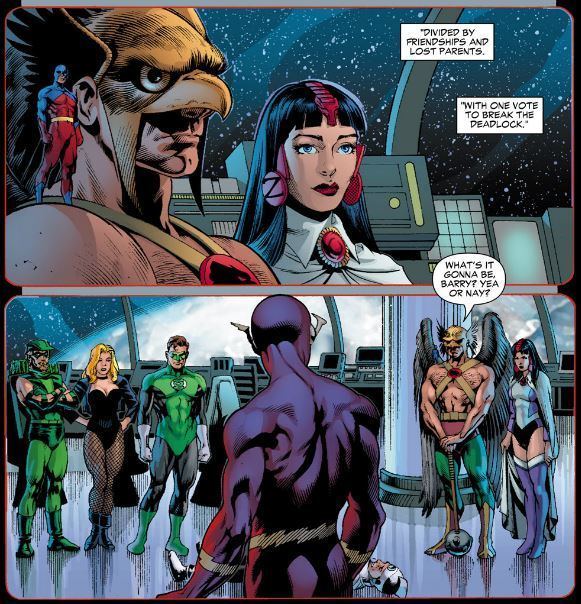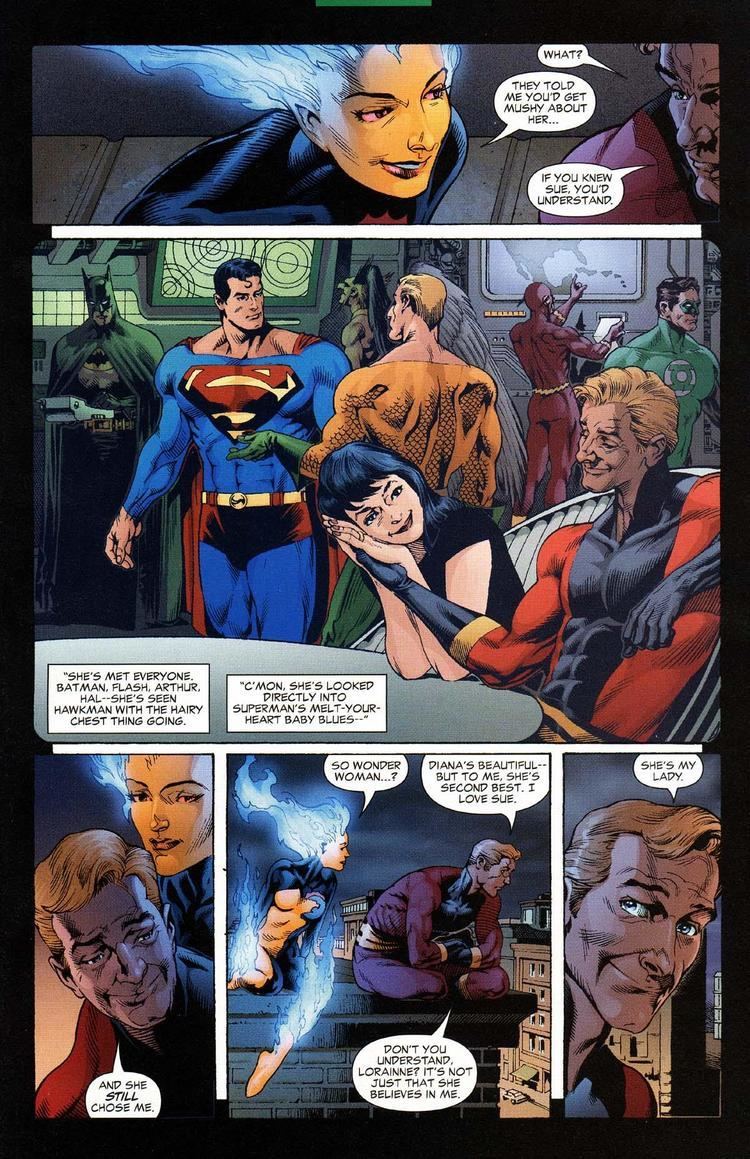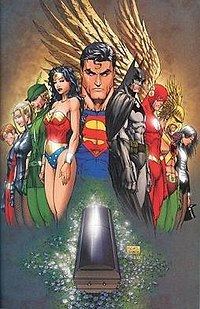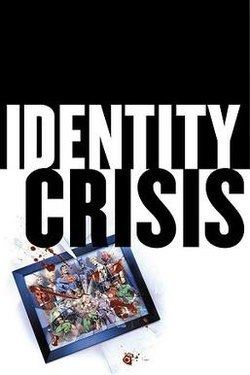Schedule Monthly Publication date June – December 2004 | Number of issues 7 | |
 | ||
Main characters Similar | ||
Identity Crisis is a seven-issue comic book limited series published by DC Comics from June to December in 2004. It was created by writer Brad Meltzer and the artistic team of penciler Rags Morales and inker Michael Bair.
Contents

Publication history

One of DC's top-selling series, the first issue was released in June 2004 and was ranked first in comic book sales for that period with pre-order sales of 163,111. The second issue saw a decline in sales and ranked third in comic book sales in July 2004 period with pre-order sales of 129,852. The story also adheres to the continuity changes introduced by Crisis on Infinite Earths, as heroine Wonder Woman was retconned out of the pre-Crisis JLA. In all further references to the JLA's pre-Crisis adventures, including its origin story and the Secret Society incident, Wonder Woman is replaced by Black Canary. Following "Infinite Crisis", however, Wonder Woman is restored as a founding member.

One of the major plot threads — the breakdown of relationships within the Justice League of America — is examined in the storyline "Crisis of Conscience" in JLA #115-119 (August–December 2005). The mini-series is followed by the crossover event "Infinite Crisis".
Writer: Brad Meltzer
Brad Meltzer, growing up in a family with low income, gained his passion for books/writing through weekly visits to the library with his grandmother. His writing career started after he graduated college, from the University of Michigan, where he soon began to realize that writing was something he wanted to pursue. His writing consists of themes such as non-fiction, fiction, children's books, and comic books (such as Identity Crisis). Some of his top-selling books include: The Inner Circle, The First Counsel, and History Decoded. Meltzer was married to an attorney and have one child, a son. As well as attending the University of Michigan in 1993, he also attended Columbia Law school in 1996. Meltzer had a famous quote that said “We are all ordinary. We are all boring. We are all spectacular. We are all shy. We are all bold. We are all heroes. We are all helpless. It just depends on the day.” Meltzer and his wife both supported multiple charities such as, Big Brothers/Big Sisters, The Arc, City Year, American Cancer Society, The National Neurofibromatosis Foundation, and Sharsheret. Many of these causes work their way into Brad’s novels. Big Brothers/Big Sisters is in Dead Even: The Arc and NF in the Fist counsel.
Plot summary
While Elongated Man is on a stakeout, during which a minor villain called Bolt is shot and wounded by criminals, his wife Sue Dibny is murdered in their apartment, apparently dying of burns. The DC superhero community rallies to find the murderer, with recurring villain Doctor Light being the prime suspect. Green Arrow reveals to the Flash (Wally West) and Green Lantern (Kyle Rayner) that Light once raped Sue Dibny in the JLA satellite headquarters. To ensure this could not happen again, League members at that time — Atom (Ray Palmer), Black Canary, Hawkman, Green Lantern (Hal Jordan), and a very reluctant Flash (Barry Allen) — voted to allow the sorceress Zatanna to mind-wipe the villain and alter his personality to an ineffectual buffoon.
Further discussion reveals that a mind wipe was also done on at least one other occasion: When the Secret Society of Super Villains (the Wizard, Floronic Man, Star Sapphire, Reverse-Flash, and Blockbuster) captures JLA members Superman, Batman, Flash, Green Lantern (Hal Jordan), Zatanna and Black Canary (Wonder Woman in the pre-Crisis continuity) and switched bodies with the heroes, allowing the villains to learn their secret identities by casually removing the heroes' masks. Although the heroes defeated the villains, Zatanna once again erased the villains' memories of the incident and their knowledge of the secret identities. Green Arrow's words also imply that they have done this on other occasions when their secret identities were threatened by magic or other means.
The heroes locate Light, who has hired the mercenary Deathstroke to protect him. During the ensuing battle, Light regains his memory and, enraged by the violation, uses his formerly lost powers to escape. Although questioned by Superman, Wally West continues to protect the heroes and their secret. Atom finds his estranged ex-wife, Jean Loring, hanging from a door, blindfolded and gagged, and revives her just in time, however she is unable to describe her attacker. A death threat is then sent to Superman's wife, Lois Lane. Flash Rogues gallery villain Captain Boomerang (Digger Harkness) is hired by third-rate villain the Calculator (on behalf of the real killer) to assassinate Jack Drake, father of Robin, Tim Drake. Jack finds a gun and a note warning him of the impending attempt on his life, and fatally shoots Boomerang who also kills him. Tim Drake comes upon the aftermath of this and is comforted by partner Batman, who confiscates the note before the authorities or the media can learn of its existence.
During questioning of several villains by the heroes, former League member Firestorm (Ronnie Raymond) is stabbed through the chest with the sword of the Shining Knight by the villain the Shadow Thief. Firestorm's nuclear powers reach critical mass and he detonates in the atmosphere.
Wally West questions Green Arrow again after accidentally seeing a snapshot of the battle on the Satellite in Light's mind, which reveals that Batman was also present. Green Arrow confesses that Batman had left immediately after the battle, but unexpectedly returned just as the mind wipe was taking place. He disapproved of this and nearly attacked the other heroes; he was magically restrained and his memory of the incident was removed. Batman uses his detective skills to find the hideout of the Calculator, but discovers the villain anticipated this and abandoned it. The autopsy of Sue Dibny's body by Doctor Mid-Nite and Mister Terrific, members of the Justice Society, reveals Dibny was killed by an infarction in her brain. A microscopic scan of Dibny's brain reveals tiny footprints as a clue to the infarction's cause.
Doctor Mid-Nite and Mister Terrific realize, as does Batman in the course of his own investigation, that Dibny was murdered by an assassin with access to the technology of the Atom, which allows the ability to shrink to subatomic size. Almost simultaneously, Palmer learns that Jean is aware of the note sent to Jack Drake (which had been kept secret) and deduces she is the killer. Loring claims she did not mean to kill Sue, and it was not her intention for Jack Drake to be killed, arguing that she sent the note and gun so he could protect himself. Loring states that she undertook the plan (including faking the attempt on her own life) in order to bring Ray back into her life. Palmer says that she is insane, and Loring is committed to Arkham Asylum and kept under heavy medication. In the final scene with the Justice League, Wally West is awkward in the presence of Batman, who is suspicious of his behavior.
Aftermath
The ramifications of this story are depicted in the title Flash, as his Rogues gallery villains band together at the funeral of Boomerang, a one-shot "Countdown to Infinite Crisis", as well as one of its tie-ins, The OMAC Project, and the title JLA, which reveals that Batman remembered the events in question at some point after. Batman's suspicions of his fellow heroes' conduct lead him to create the Brother MK I satellite to monitor superhumans, which is an important factor in the subsequent crossover storyline "Infinite Crisis".
Awards
The miniseries was selected by the Young Adult Library Services Association (YALSA)'s 2007 recommended list of Great Graphic Novels for Teens.
Collected editions
DC Comics reprinted the Identity Crisis mini-series in April 2005 with recolored covers. A hardcover collection (ISBN 1-4012-0688-3) was printed in September 2005, with bonus features including a commentary by Meltzer and Morales; the creative team citing favorite moments, and a look at Morales' sketchbook.
A paperback collection (ISBN 1-4012-0458-9) was released on August 16, 2006. The paperback collection ranked third in the top 100 graphic novels for the August 2006 period with pre-order sales of 7746.
An Absolute Edition of Identity Crisis was released on October 12, 2011.
